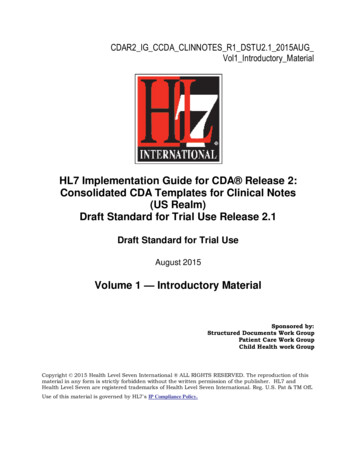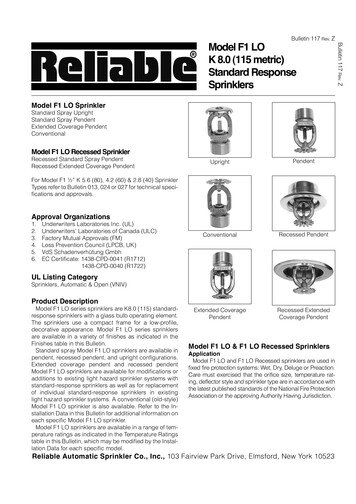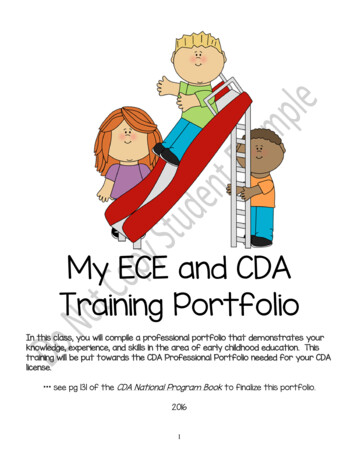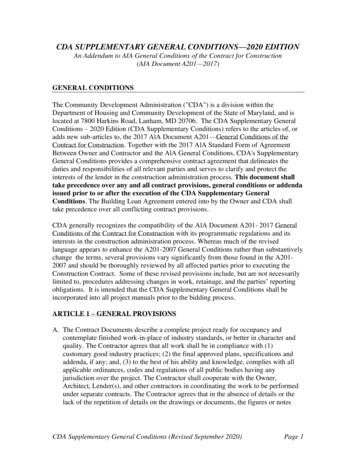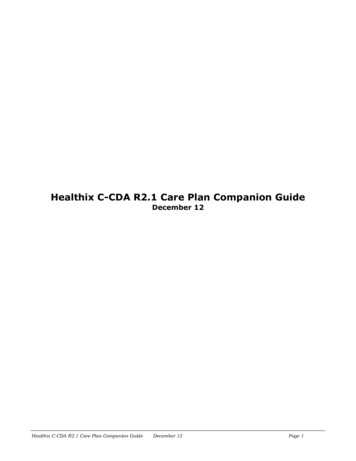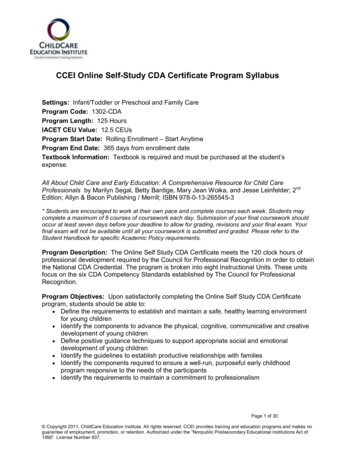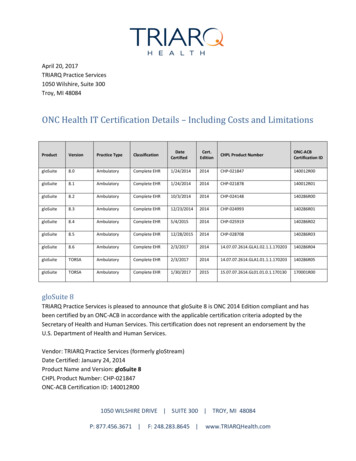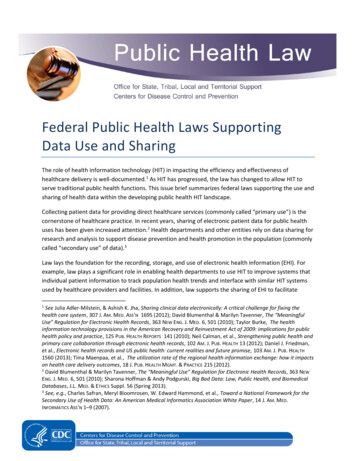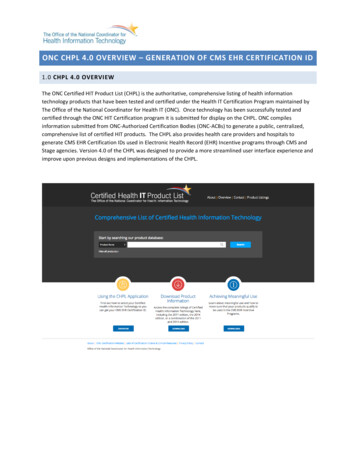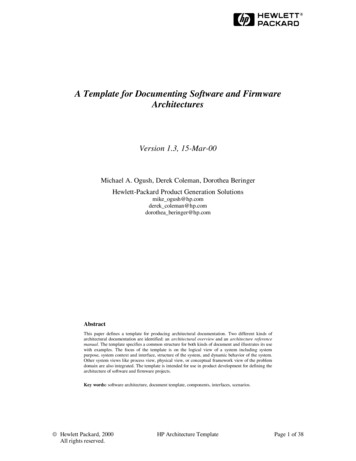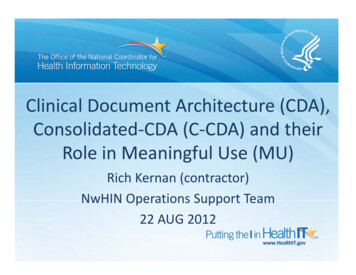
Transcription
Clinical Document Architecture (CDA),Consolidated-CDA (C-CDA) and theirRole in Meaningful Use (MU)Rich Kernan (contractor)NwHIN Operations Support Team22 AUG 2012
Learning ObjectivesAfter completing this course, you will be able to: Describe how healthcare data was exchanged prior to Electronic HealthRecords (EHRs) Describe the purpose, functionality, usage and structure of the ClinicalDocument Architecture (CDA) Describe the usage of Implementation Guides (IGs) and Templates in CDA Describe the context, process, purpose and navigation of theConsolidated-CDA (C-CDA) IG Describe how C-CDA satisfies CDA-specific MU objectives Summarize the linkages between CDA, C-CDA and MUOffice of the National Coordinator forHealth Information Technology2
Describe how healthcare data was exchangedprior to Electronic Health Records (EHRs)Office of the National Coordinator forHealth Information Technology3
Healthcare Data Exchange(Pre-EHR)Vast amounts of patient datacollected through direct clinicalinteractionsMedical information such as vitals,orders, prescriptions, dischargesummaries, etc. dictated orrecorded by handAll of this clinical data was storedas paper records (documents) ateach point of careIf patient health records needed tobe shared between providers, theyusually required manual exchange(e.g. fax, “snail mail”) Coordination of care between providers slow, costly; patient outcomes inconsistent Duplicative healthcare services (e.g. labs imaging) frequentOffice of the National Coordinator forHealth Information Technology4
Describe the purpose, functionality, usage, andstructure of HL7’s Clinical Document Architecture(CDA)Office of the National Coordinator forHealth Information Technology5
Clinical Document Architecture(CDA) OverviewAn international not-for-profit SDO with 2,300 members across 500 corporations representing 90% of IS vendors serving Healthcare.Dedicated to providing a comprehensiveframework for the exchange and management ofhealth informationCDA is a base standard which provides a commonarchitecture, coding, semantic framework, andmarkup language for the creation of electronic clinicaldocuments CDA Docs are coded in Extensible Markup Language (XML) HTML describes presentation, XML describes content Human readable and machine interpretableTemplated: standardized groupings of information organizedaccording to clinical contextObject Oriented: makes use of classes, associations, andinheritance; allows tremendous flexibility and re-useOffice of the National Coordinator forHealth Information Technology6
CDA conformant Continuity ofCare Document (CCD) exampleOffice of the National Coordinator forHealth Information Technology7
CDA conformant CCD example(underlying XML)Office of the National Coordinator forHealth Information Technology8
CDA Purpose & FunctionalityCDA defines the structure of building blocks whichcan be used to contain a multitude of healthcaredata elements that can be captured, stored,accessed, displayed and transmitted electronicallyfor use and reuse in many formatsCDA DOES NOT specify how documents are transported,simply how critical data elements should be encoded forexchange and interoperabilityCDA can contain both structured and unstructuredinformationOffice of the National Coordinator forHealth Information Technology9
CDA UsageCDA defines buildingblocks which can beused to containhealthcare dataelements that can becaptured, stored,accessed, displayedand transmittedelectronically for useand reuse in manyformatsSets of these CDAstandardized buildingblocks can be arranged forwhatever needs existArranging (or constraining) theCDA elements in defined waysusing IGs and templatesproduces clinical documentsThis approach offerstremendous flexibility; itallows for the creation of acomprehensive variety ofclinical documents whichshare common designpatterns and use a singlebase standarde.g. a Discharge Summary andan Op Note both draw from thesame CDA schema but arescoped for different use casesOffice of the National Coordinator forHealth Information Technology10
CDA Document StructureExampleOffice of the National Coordinator forHealth Information Technology11
CDA Structure: OverviewEvery CDA document must have ATLEAST a Header AND a One Section.XML enables both humanand machine readability.The XML structure for aCDA document nests datain the following way:» Header» Body» » Section(s)» » » Narrative Block» » » Entry(s)Office of the National Coordinator forHealth Information Technology12
CDA Structure: HeaderThe Header sets the contextfor the clinical document as awhole and: enables clinical documentexchange across andwithin institutions; facilitates clinicaldocument management ;and facilitates compilation ofan individual patient'sclinical documents into aelectronic patient record.Office of the National Coordinator forHealth Information Technology13
CDA Structure: BodyThe Body contains the clinicalreport and can contain anunstructured “blob” orstructured content organizesin one or more Sections.Office of the National Coordinator forHealth Information Technology14
CDA XML Structure: Section(s)Each Section contains oneNarrative Block and zero tomany coded Entries.Examples include: Allergies Meds Problems Immunizations Vital SignsOffice of the National Coordinator forHealth Information Technology15
CDA XML Structure: KENTRIESNarrative Blocks allows“human-readability” of a CDAdocument. Within adocument section, thenarrative block representscontent to be rendered forviewing.The Narrative Block has fixedmarkup, and must bepopulated by the documentoriginator.Office of the National Coordinator forHealth Information Technology16
CDA XML Structure: tries allows “machine readability” (e.g. decisionsupport applications). Withina document section, an entryrepresents structuredcontent for further computerprocessing.Office of the National Coordinator forHealth Information Technology17
Describe the usage of Implementation Guides(IGs) and Templates in CDAOffice of the National Coordinator forHealth Information Technology18
CDA Templates andImplementation Guides (IGs)CDA Implementation Guides (IGs)CDA Templates serve as a how-to-guide for usingCDA to satisfy a given use case constrain elements in the CDAschema as needed to define functionspecific information objects e.g. a CCD must contain an “Allergy,Adverse Reactions, Alerts” section includes subset of CDA templateswhich contain information relevantto a Use Case IGs generally define documentTemplates e.g. CCD vs. Discharge Summary 8 critical CDA documentsconsolidated into single guide:Consolidated-CDA (C-CDA) IG e.g. defines what data is contained inan “Allergy, Adverse Reactions,Alerts” section used by multiple CDAdocuments provides a collection of business ruleswhich apply to CDA componentsapplied at multiple levels: HeaderDocumentSectionEntryOffice of the National Coordinator forHealth Information Technology19
Template ExampleOffice of the National Coordinator forHealth Information Technology20
Describe the context, process, purpose andnavigation of the Consolidated-CDA (C-CDA) IGOffice of the National Coordinator forHealth Information Technology21
Pre-Consolidation ContextBefore Consolidation, providers trying toimplement a specific clinical document (e.g.C32) were faced with a “rabbit hole” ofcross-referenced materials creating an evergrowing, complex web of documentation –Consolidation was undertaken to addressthis issue. Duplicative and conflicting IGs published by different standards organizations (e.g. HITSP, HL7,IHE, Health Story); approved/balloted at different timesImplementers faced with confusing collection of documents containing ambiguous and/orconflicting informationC-CDA IG includes the following clinical documents (year released): Consultation Note (2008);Discharge Summary (2009); Imaging Integration and DICOM Diagnostic Imaging Reports (DIR)(2009); History and Physical (H&P) (2008); Operative Note (2009); Progress Note (2010);Procedure Note (2010); and Unstructured documents (2010)Office of the National Coordinator forHealth Information Technology22
Consolidation ProcessAs disparate SDOs (HL7, IHE, HITSP, etc.) developedCDA IGs, multiple approaches for documentingtemplate requirements began to divergethreatening interoperability –S&I hosted a collaboration among the standardscommunity in order to address CDAdocumentation issues which were hamperingunderstanding and consistent implementation inorder to: examine and analyze CDA Templates across theexisting documentation identify and address errors, issues of ambiguity, andconflict consolidate prior documentation to a new single IGand ballot (approve) through HL7– Consolidation harmonized and balloted previoustemplates a single IGOffice of the National Coordinator forHealth Information Technology23
C-CDA IG Purpose: Single Sourcefor CDA TemplatesHL7 Implementation Guide for CDA R2:IHE Health Story Consolidation, DSTURelease 1.1(US Realm)July 2012Document Templates: 9 Continuity of Care Document (CCD) Consultation Note Diagnostic Imaging Report (DIR) Discharge Summary History and Physical (H&P) Operative Note Procedure Note Progress Note Unstructured DocumentSection Templates: 60Entry Templates: 82DocumentTemplateSection Template(s)CCDAllergiesMedicationsProblem mily HistoryFunctional StatusImmunizationsMedical EquipmentPayersPlan of CareHistory andPhysicalAllergiesMedicationsProblem ListProceduresResultsFamily HistoryImmunizationsAssessmentsAssessment andPlanPlan of CareSocial HistoryVital SignsHistory of PresentIllnessHistory of PresentIllnessSection templateshighlighted in thetwo sectiontemplateexamples heredemonstrateCDA’sinteroperabilityand reusability.Chief ComplaintReason for VisitReview of SystemsPhysical ExamGeneral StatusC-CDA includes all templates in Final Rules for Stage 1 Meaningful Use, 45 CFRPart 170 – Health Information Technology and Cert. Criteria for ElectronicHealth Record: Final RuleOffice of the National Coordinator forHealth Information Technology24
C-CDA IG NavigationChapter 1: IntroductionChapter 2: General Header Template – defines a template forthe header constraints that apply across all of the consolidateddocument typesChapter 3: Document-Level Templates – defines each of the ninedocument types; defines header constraints specific to each andthe section-level templates (required and optional) for eachChapter 4: Section-Level Templates – defines the sectiontemplates referenced within the document types describedChapter 5: Entry-Level Templates – defines entry-leveltemplates, called clinical statements (machine readable data)Appendices – include non-normative content to supportimplementers; includes a Change Appendix summary of previousand updated templatesClick this link to access more information about the HL7Implementation Guide for CDA Release 2: IHE Health StoryConsolidation, Release 1.1 - US Realm http://www.hl7.org/implement/standards/product brief.cfm?product id 258 Office of the National Coordinator forHealth Information Technology25
Describe how C-CDA satisfies CDAspecific MU objectivesOffice of the National Coordinator forHealth Information Technology26
Meaningful Use (MU) OverviewMeaningful Use objectives are the measurable benchmarks that eligible healthcare professionals and hospitals must meet in adopting and using EHR technologyto qualify for Medicare and Medicaid incentive payments.CMSMedicare andMedicaidPrograms:Electronic HealthRecord IncentiveProgram: FinalRule28 JUL 2010Eligible Professionals (EP):Eligible Hospitals (EH): EPs (doctors and other medicalprofessionals) must choose toparticipate in either the Medicareand Medicaid Incentive Programupon registration.Generally, EPs must have aminimum 30% Medicaid patientvolume to qualify for Medicaidpayments.Before 2016, an EP may switchprograms after the first payment. Office of the National Coordinator forHealth Information TechnologyThe Medicare Program recognizes“subsection (d) hospitals, CriticalAccess Hospitals, and MedicareAdvantage Hospitals. The MedicaidProgram recognizes Acute carehospitals with a minimum 10%Medicaid patient volume andChildren’s Hospitals.Hospitals may be eligible andreceive payments under bothprograms.27
MU Standards & CertificationCriteria (S&CC) (proposed 2014)Meaningful UseCert. Criteriameaningful use objectives are the measurable benchmarks that eligible health care professionals and hospitalsmust meet in adopting and using EHR technology to qualify for Medicare and Medicaid incentive paymentsObjectiveDescriptionMU S&CC Final Rule establishes HL7’s CDA as the standard per C-CDA IG – 2 objectives above conceptualized together as “Summary of Care” recordCare CoordinationPatientEngagementTransition of CareView/Download/TransmitClinical Summarywhen transitioning a patient to another care setting, theprovider should provide a summary care recordpatients must be able to view and download their own medical infoand also be able to transmit that info to a 3rd partyproviders must make office visit summaries available topatients subsequent to a visitNon-CDA-related MU S&CC not shown here because they are outside the scope of this trainingClinicalCQMsPrivacy & SecurityPublic HealthMU S&CC Final Rule establishes HL7’s CDA as the standard per C-CDAIG – 2 objectives above conceptualized together as “Summary of Care”recordNon-CDA-related MU S&CC not shown here because they are outsidethe scope of this trainingUtilizationOffice of the National Coordinator forHealth Information Technology28
Summarize the linkages between CDA,C-CDA and MUOffice of the National Coordinator forHealth Information Technology29
CDA, C-CDA & MU LinkagesClinical Document Architecture (CDA)CDA provides single standardized, interoperable schema for the creation of clinical documents CDA is XML-based clinical document standard using common, reusable data elements Supports human- AND machine-readability CDA unique CDA implementation guides (IGs) » CDA-conformant clinical documentMeaningful Use (MU)MU “ rewards the ‘meaningful use’ ofhealth IT not the purchase of health IT.” Currently in Stage I; moving towardsStage IIConsolidated-CDA (C-CDA) IGMUC-CDA IG critical to fulfilling MU S&CCobjectives for standardization,interoperability of EHRs C-CDA IG harmonizes numerous CDAstandards Early adopters rewarded; non compliance eventually penalized IGs for 8 key clinical documents unstructured documents consolidatedinto C-CDA MU-2 focuses on 7 key criteria (2achieved using C-CDA)Office of the National Coordinator forHealth Information Technology30
Thank you for your participationThis concludes today’s training concerning“CDA, C-CDA and Their Role in Meaningful Use”.For more information of these and other relatedtopics, visit the ONC websitehttp://www.healthit.govOffice of the National Coordinator forHealth Information Technology30
Clinical Document Architecture (CDA) Overview . An international not-for-profit SDO with 2,300 members across 500 corporations representing 90% of IS vendors serving Healthcare.
